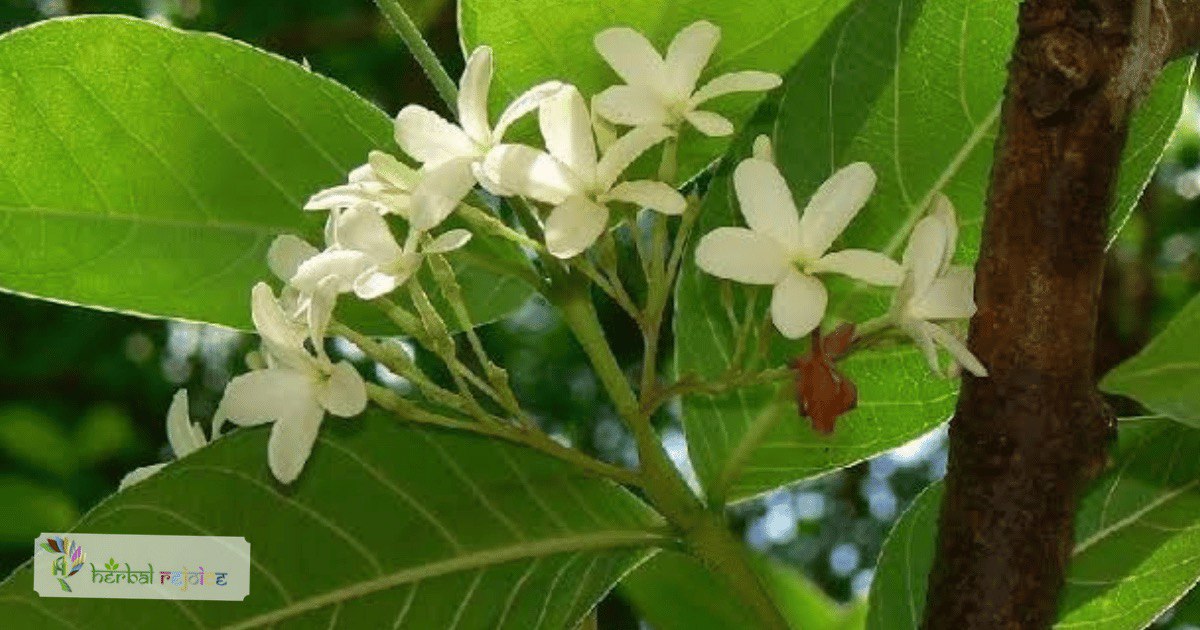Introduction
Ivory tree (Holarrhena antidysenterica Linn.) Wall, also known as Easter tree, is a plant that belongs to the Apocynaceae family.
The root, bark and seeds of Ivory tree is used to treat dysentery, helminthic disorders, colic, dyspepsia, piles, and diseases of the skin and spleen.
Names and Habitat
In Ayurveda, this plant is known as Kutaja, Girimallikaa, Kaalinga, Kalingaka, Indravriksha, Shakra, Vatsa, Vatsaka, Shakraahvya, Indrayava, Indrabija, Vatsabija for its various medicinal properties.
It is native to the tropical Himalayas and can be found at altitudes of up to 1,100 m. It is also commonly found in forests throughout India, including regions like Travancore, Assam, and Uttar Pradesh.
The Unani system of medicine refers to it as Inderjo talkh and Teewaaj-eKhataai, while Siddha/Tamil calls it Kudasappaalai-pattai and -vidai.
Traditional Uses Of Ivory tree
The root and bark of Ivory tree are commonly used in the treatment of amoebic dysentery. The bark is known for its astringent, anthelmintic, amoebicidal, and diuretic properties.
It is used to alleviate symptoms of colic, dyspepsia, piles, as well as various skin and spleen-related conditions.
The seeds of this plant are antibilious and are believed to promote conception and tone up vaginal tissues after delivery.
Key Components Of Ivory Tree
This plant contains several alkaloids, including regholarrhenine-A, -B, -C, -D, -E and -F, pubescine, norholadiene, pubescimine, kurchinin, kurchinine, kurchinidine, holarrifine, holadiene, kurchilidine, kurchamide, kurcholessine, kurchessine, conessine, conessimine, and isoconessimine.
The alkaloid conessine is particularly notable, as it is used as a therapeutic drug for the treatment of dysentery and helminthic disorders.
In vitro studies have shown that conessine and conimine inhibit the growth of Shigella sonnei, S. flexneri, and Salmonella enteritidis strains.

Potential Health Benefits Of Ivory Tree
Additionally, Holarrhena antidysenterica has been found to possess immunostimulant properties.
It is also worth mentioning that the seeds of this plant are sometimes sold as a substitute for Strophanthus sp. seeds in the Indian market.
This is significant because Strophanthus sp. seeds contain a toxic glucoside called strophanthin, making them poisonous.
Dosage
When using Ivory tree, a decoction can be made from 20-30 g of stem bark.
The powdered seeds can be taken in doses of 3-6 g, or a decoction can be made using 20-30 g of seeds.
Conclusion
In conclusion, Ivory tree is a versatile plant with various medicinal uses. Its bark, root, and seeds have been traditionally used in the treatment of conditions like dysentery, helminthic disorders, colic, dyspepsia, piles, and diseases of the skin and spleen.
Its alkaloid content, including conessine, makes it an effective therapeutic option. Additionally, it has immunostimulant properties and can be used as a substitute for poisonous Strophanthus sp. seeds.
When using this plant, it is important to follow the recommended dosages for optimal results.
Frequently sked Questions(FAQs)
What is Holarrhena antidysenterica?
Holarrhena antidysenterica, also known as Easter tree or Ivory tree, is a plant belonging to the Apocynaceae family.
Where is Holarrhena antidysenterica native to?
Holarrhena antidysenterica is native to the tropical Himalayas.
Where can Holarrhena antidysenterica be found in India?
Holarrhena antidysenterica can be found in forests throughout India, including regions like Travancore, Assam, and Uttar Pradesh.
What are the medicinal properties of Holarrhena antidysenterica?
Holarrhena antidysenterica is known for its medicinal properties, including astringent, anthelmintic, amoebicidal, and diuretic properties.
What conditions is Holarrhena antidysenterica used to treat?
Holarrhena antidysenterica is commonly used in the treatment of amoebic dysentery. It is also used to alleviate symptoms of colic, dyspepsia, piles, and various skin and spleen-related conditions.
What part of Holarrhena antidysenterica is used in medicine?
The root and bark of Holarrhena antidysenterica are commonly used in medicine.
What are the properties of the bark of Holarrhena antidysenterica?
The bark of Holarrhena antidysenterica is known for its astringent, anthelmintic, amoebicidal, and diuretic properties.
What are the properties of the seeds of Holarrhena antidysenterica?
The seeds of Holarrhena antidysenterica are antibilious and are believed to promote conception and tone up vaginal tissues after delivery.
What are the alkaloids found in Holarrhena antidysenterica?
Holarrhena antidysenterica contains several alkaloids, including conessine, regholarrhenine, pubescine, norholadiene, pubescimine, kurchinin, kurchinine, kurchinidine, holarrifine, holadiene, kurchilidine, kurchamide, kurcholessine, kurchessine, conessimine, and isoconessimine.
What is conessine used for?
Conessine, an alkaloid found in Holarrhena antidysenterica, is used as a therapeutic drug for the treatment of dysentery and helminthic disorders.
What strains of bacteria does conessine inhibit the growth of?
In vitro studies have shown that conessine inhibits the growth of Shigella sonnei, S. flexneri, and Salmonella enteritidis strains.
What other medicinal properties does Holarrhena antidysenterica have?
Holarrhena antidysenterica has been found to possess immunostimulant properties.
How is Holarrhena antidysenterica used in Ayurveda?
Holarrhena antidysenterica is known as Kutaja, Girimallikaa, Kaalinga, and other names in Ayurveda. Its various parts are used for different medicinal purposes.
How is Holarrhena antidysenterica used in the Unani system of medicine?
In the Unani system of medicine, Holarrhena antidysenterica is referred to as Inderjo talkh and Teewaaj-eKhataai. It is used for its medicinal properties.
How is Holarrhena antidysenterica used in Siddha/Tamil medicine?
In Siddha/Tamil medicine, Holarrhena antidysenterica is known as Kudasappaalai-pattai and -vidai. It is used for medicinal purposes.
Can Holarrhena antidysenterica be used as a substitute for Strophanthus sp. seeds?
Yes, the seeds of Holarrhena antidysenterica are sometimes sold as a substitute for Strophanthus sp. seeds in the Indian market.
Why is using Holarrhena antidysenterica as a substitute for Strophanthus sp. seeds significant?
Strophanthus sp. seeds contain a toxic glucoside


